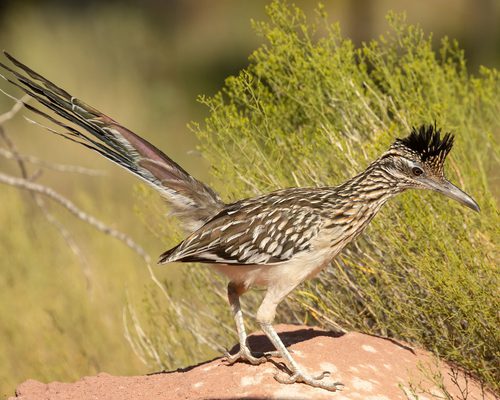Roadrunners more than make up for their smaller stature and lack of coloration with their lightning-fast speed; you might be surprised to learn these lanky birds are actually fierce predators.
Standing motionless beside a patch of scrub brush, they'll suddenly snap forward like a released spring, snatching up lizards with deadly accuracy.
Watch them patrol along fence lines with their head held low, then freeze completely when they spot potential prey - those distinctive salt glands near their eyes giving them an almost alien appearance while helping them conserve precious water in the desert heat.
These birds absolutely demolish the local lizard population during the summer months. Watch them long enough, and you'll see them dart off with everything from chunky horned lizards to quick little fence swifts, often bashing larger prey against rocks to disable it before swallowing it whole.
They're particularly fond of whiptails, which you can tell by the way they'll chase them down at full sprint, zigzagging through the brush. Young roadrunners learn these hunting skills from both parents over 30-40 days, starting with soft insects before graduating to harder prey.

A Roadrunner with a lizard prey
What really gets attention is their snake-hunting technique. When taking on rattlesnakes, they'll dance around just out of strike range, wearing the snake down before grabbing it behind the head.
Even more impressive is their teamwork - sometimes pairs work together, one distracting while the other strikes from behind. Their ability to handle venomous prey seems almost supernatural - they can tackle everything from rattlers to scorpions without any ill effects.

Roadrunner hunting a western diamondback rattlesnake
Come winter, when reptiles are scarce, roadrunners switch tactics entirely. Though they make up for the scarcity by incorporating more seeds and fruits - about 10% of their winter diet - they're still primarily hunters.
They'll perch on high points watching for small birds, then launch themselves like feathered missiles to snatch them right out of the air.
Despite those famous cartoon chases, they actually can't outrun a coyote - their predator's 40 mph speed beats their 25 mph sprint. Instead, they rely on quick maneuvering and their ability to slip into tight spots for protection.

Roadrunner with a freshly caught mouse
The really clever bit is how they handle larger prey. After a successful catch, they'll often find a shady spot and cache part of their meal for later, wedging it into the fork of a cholla cactus or tucking it under a rocky overhang.
You might spot one running around with a snake's tail hanging from its beak - they'll gradually swallow it bit by bit as their stomach makes room, sometimes taking hours to finish a single meal.
At day's end, you'll often spot them sunbathing with raised feathers, warming up after the desert's chilly nights - just another survival trick that helps these remarkable birds thrive in such harsh conditions.

Roadrunner drinking water

